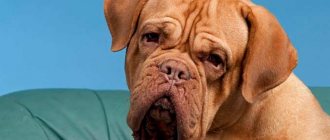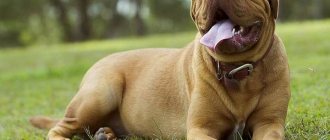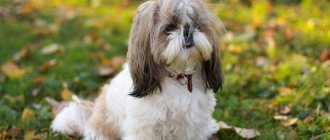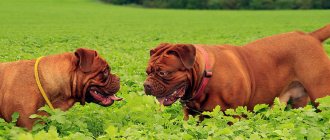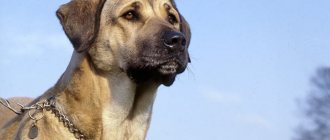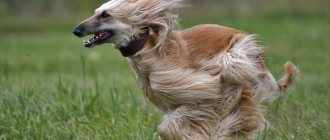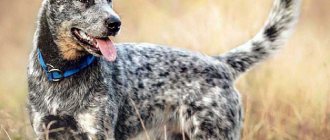Lancashire heeler - almost extinct and restored in the 1960s. a native British breed of miniature herding dog.
Lancashire Heelers gained the greatest popularity in their homeland - in England, Wales, Scotland, as well as in the Scandinavian countries - Sweden, Norway, Finland.
Among the herding breeds, Lancashire Heelers are the smallest, barely reaching thirty centimeters at the withers and weighing only a couple of kilograms.
This circumstance does not detract from the working qualities of Lancashire, which for many centuries were actively used by farmers for grazing and driving livestock, as well as hunting rats and mice.
Description and features
Despite the fact that the Lancashire Heeler has not been officially adopted, some parameters are considered mandatory for this dog.
- The physique is strong, harmoniously built. Outwardly, the dog looks squat, but quite powerful. The body is longer than it is tall; such animals are said to have a “rectangular body.” The body is distinguished by a straight, strong back, a fairly powerful chest and rounded hips.
- The ideal height for males is 30 cm, for females – 25 cm.
- The coat should completely hide the undercoat. Color: dark chestnut (almost black) or red with tan. The coat looks shiny, feels rough and smooth. The undercoat protects the dog in any bad weather and allows the dog to remain dry in rain and snow. In winter, the “robe” becomes longer and denser than in the summer, and a “scruff” is noticeable. Regarding color, the color usually looks like black or brown with tan. A white spot on the chest is allowed. But these “colored” deviations are recognized by the Kennel Club.
The standard does not specify weight and some other characteristics, but breeders prefer to indicate them:
- Weight can range from 3 to 8 kg
- The ears are triangular in shape and set wide apart. When tense, they can be slightly tilted forward, but stand in a calm position.
- The head is slightly flattened vertically, wedge-shaped in shape. The eyes are almond-shaped, medium in size, usually brown and very expressive. The bite is correct, scissor-shaped. The teeth must be completely complete.
- The paws are short but strong, broad-boned, with well-developed muscles. The hind legs may be slightly turned outwards, but this should not affect movement.
- The tail is quite long, slightly curved at the end, set high, thick at the base, and always in motion. It is not customary to buy it.
Despite its rather small size, the Lancashire Heeler dog is distinguished by unexpected strength and excellent working abilities. In addition, they must be “energetic and alert,” according to the same unwritten standard.
Breeding the breed abroad (recommendations)
The Lancashire Heeler breed has a relatively small genetic pool, so using inbreeding (close inbreeding, with a coefficient higher than 6.25) is not advisable.
According to English Kennel Club rules, all certified breeders are required to test their dogs annually for PLL before using them for breeding. In the UK, CEA testing is a recommendation.
In Sweden, which still has the largest population of Lancashire Heelers in Scandinavia, testing for eye diseases is mandatory. Both sires must be tested a maximum of 12 months before the intended breeding date.
According to the requirements of the Finnish Kennel Club, producers must be examined for patella and hereditary eye diseases found in the breed. Eyes are checked no earlier than 6 months before the expected mating date. Dogs with PLL, PRA, PHTVL/PHPV grades 2-6, as well as with CEA-coloboma and those operated on for CEA are excluded from breeding. According to the rules of the Finnish Kennel Club, a sire can have no more than 20 puppies in a lifetime. It is interesting that in Finland they carried out the practice of an “open book of matings”, when dogs without a pedigree (“farm heelers”) were allowed for breeding use in order to expand the genetic pool.
In Norway, all requirements for manufacturers are advisory in nature. Both producers must be mentally and mentally healthy, registered with NKK and have their own ID (pedigree). Cryptorchids and dogs with malocclusion should not be bred. The requirements for testing time for eye diseases are the same as in Sweden. Dogs with first degree PHTVL/PHPV can be bred to dogs that are clear of this disease. Dogs with higher degrees of PHTVL/PHPV are not allowed for breeding. The breeding bitch must be over 2 years old, the male – 18 months (it is also recommended to wait two years). The inbreeding coefficient should not exceed 6.25. Both manufacturers must have exhibition ratings of at least “very good”. Both sires must pass character testing and have a full set of teeth. It is recommended that both sires be tested for CEA and PLL, with the possibility that one of the sires may be a carrier of the disease.
Kinds
Since the breed is still in the development stage, there are different types of specimens among it. The main differences are in the color and structure of the coat. However, it is not distinguished by variety. Rather, it can be divided into several types according to use:
- shepherds and beaters;
- hunters and watchmen;
- companions and assistants who are always nearby, at your feet (actually “heeler” can be translated from one of the English slangs as “henpecked”),
- sporting dogs;
- rescue dogs.
All these qualities, in fact, can be inherent in the same dog. We can say that the Lancashire Heeler is a universal dog. Closest relatives are Welsh Corgis (Welsh Corgis) and Manchester Terriers. A few words about these breeds.
Welsh Corgis (Pembroke and Cardigan) - according to Welsh legend, these dogs were a gift to humanity from fairies, because people supported them in their conflict with greedy gnomes. Dogs have darker colored fur on their backs, like a saddle, which was used by the winged fairies who chose these animals to travel.
Legendary shepherd dogs look a bit like fox cubs, with lots of light red, smooth fur combined with soft white fur. Three colors are also allowed within the breed - red-white-black, just black (rarely) and brindle colors. White markings are possible with any color.
Short legs, erect ears, squat long body, medium-length tail and very attentive brown eyes. This charming dog has an ancient pedigree, belongs to the Shepherd Dogs, and is truly considered a royal breed. In the early 30s of the last century, Queen Elizabeth II of England received a representative of this breed as a gift from her father.
Manchester Terriers are also a British dog breed, developed in the early 19th century. It owes its appearance to the struggle of the British against unsanitary conditions at that time, in particular, against the rats that infested the country. The fighting and swift dog successfully coped with its task. His tenacious grip and strong jaws allowed him to practically tear his victim in two.
Their size did not exceed 40 cm, weight was about 5-8 kg. The British carried a small hunter with them in special leather bags. The coat is smooth, black and tan in color, the ears are usually half-dropped, but erect when tense.
One of the oldest official terrier breeds. The Lancashire Heeler in the photo may remind someone of a Welsh Corgi, but a connoisseur will immediately see the differences. The Lancashire is distinguished by its smaller size, higher paws and rounded head shape.
Finland
- Bovenop (Marketta Lähdekorpi)
- Coppercoat´s (Krista Rantanen)
- Daamin (Anne Tanskanen)
- Heartbay's (Merja Huuskonen)
- Hightide's (Mervi Nousiainen)
- Kauhia Kartano (Teija Salomaa)
- Keep Loving (Natasha Murola)
- Kotisaaren (Kirsi Kotisaari)
- Liiterikoiran (Tuija Hatakka)
- Limespirit (Eeva Tuomisto)
- Lindkullas (Stina Nässling)
- Marmalade's (Anna Niiranen)
- Minimonsteri (Anna Kulmakorpi)
- Mustan Linnan (Tiina Hynninen)
- Myheels (Eeva Teräväinen)
- Peikkonevan (Katriina Neva)
- Pinpoint (Pia Markkanen)
- Pull Moon (Heta Hassel)
- Stalker (Riitta ja Pekka Hahto)
- Stallmästarens (Eva Stadius)
- Tarmonpesän (Tiina Siimekselä)
- Tsarodej (Riitta Ajanto)
History of the breed
As is often the case with ancient breeds, it is difficult to determine their exact origins. One thing is certain - Lancashires appeared in England. Once upon a time, more than 200 years ago, a breed of Welsh Corgi was used to herd domestic animals from Wales to the northern and western parts of England.
In the Ormskirk area, whether by accident or design, one of the Welsh Corgis crossed with a black and brown Manchester Terrier. This is presumably how the Lancashire Heeler breed . By the way, in her homeland she is also called Ormskirk heeler or Ormskirk terrier.
In its area, this dog has become quite popular among livestock owners. She did an excellent job as a driver and shepherd. Gradually, the breed died out, until in 1960, dog enthusiast Gwen McIntosh began actively restoring the dog.
In 1978, she and other breeders formed the Lancashire Heeler Club and became its president. They developed an initial breed standard and registered. Recognition by the English Kennel Club followed in 1981. Gwen McIntosh continued to serve as president until her death in 1992.
In 2006, the breed was recognized as vulnerable local. This meant that annual registration numbers did not exceed 300. In 2016, the Fédération Cynologique Internationale added the breed to its list of provisionally accepted breeds.
Owner reviews
Alexei. M: As far as I know, in St. Petersburg today there are three individuals living with private owners, and there are no other representatives of this breed in Russia. It is quite difficult to purchase such a puppy in the EU, since most breeders refuse to sell them outside the European Union. A friend of mine, a private collector from London, had a puppy - it then cost about a thousand or a half thousand euros. Selling to Russia will cost even more, since it will not be possible to buy this legally.
Character
Despite the fact that the Lancashire Heeler was bred to work in open spaces and on the street, the pet gets along well with all family members and pets. The dog is affectionate, cheerful, smart, loves everyone. Infinitely devoted to her “pack”. He is wary of strangers.
The character of the Lancashire Heeler is closer to that of the Sheepdogs, which are its supposed ancestors, the Welsh Corgi. These animals are active, smart, and respond well to a city apartment. They love to play ball games or simply run after their owner.
As already mentioned, the working purpose is to corral cows, bulls, sheep, horses and other farm animals. And also hunting for rabbits, rats, guard work. She has excellent reactions, convenient sizes and a friendly disposition.
Thanks to this, the dog is often taken as a companion and also a friend for children. In addition, it is used in rehabilitation centers for the disabled and in nursing homes in canistherapy (treatment with dogs). Can participate in various dog competitions in agility, flyball (a canine sport using a ball), show skills and team competitions.
It is advisable to engage in training from a very early age. These pets try to please their owner and are always happy to learn, so they are subject to training. The Lancashireman needs to be loved and given more attention, then he will become the dog you dreamed of.
Nutrition
Lancashire Heelers are unpretentious eaters. The diet of an adult dog can consist of natural products, where the basis is boiled meat. One fifth of the menu can be made up of cereals, boiled vegetables, and sour-milk products. You can choose premium or holistic food (natural based). In both cases, include fresh vegetables and fruits in your diet.
At first, it is recommended to give puppies cottage cheese, other fermented milk products, cereals, eggs, then you can switch mainly to a protein diet (meat). Or also choose a good ready-made food for active puppies. Having clean and sufficient drinking water is essential for Lancashire residents.
Sweden
- Axa's (Therese Löf)
- Be'Löfs (Berit Löf)
- Black Bugz (Maria Senbom)
- Bonnemins (Christine Hellmer)
- Fiffihills (Marianne André)
- Heelers.se (Anna Landqvist)
- Heffaklumpens (Malin Lindholm)
- Hillstar's (Nathalie Månsson)
- Limebrooks (Susanne Nilsson)
- Midsomer's (Johanna Wahlberg)
- Mirox (Catharina Almroth)
- Mongrel's (Lena Eliasson-Siversson)
- Moonglade's (Monica Wennerström)
- Norribäcks (Linn Broström)
- Rexstars (Rene Starö)
- Skaddedalens (Katarina Eriksson)
- Stolta Ebbas (Erika and Kent Karlsson)
- Ståhlskyttens (Veronika Ståhl)
- Tanspots (Maria Winberg)
- Tumlex (Loulou Eklund)
Reproduction and lifespan
Breeding these dogs is best left to professionals, because the important factor of paperwork, as well as the nuances and difficulties of obtaining a purebred breed, can be difficult for a beginner. Therefore, trust experienced breeders and buy yourself a purebred puppy from trusted nurseries.
From the first days a puppy appears in the house, the owner is obliged to take care of its upbringing and socialization. The optimal age for this is 2-3 months. It is important to show your pet the world around him, other animals, including cats. It is necessary to train the puppy not to “herd” people - not to grab ankles, even when playing.
Lancashire Heeler puppies need a dominant trainer because they are stubborn and intractable from childhood. It is through training and education that these qualities will be overcome. Just don’t use rudeness or violence against them.
Average life expectancy is 12-15 years. Diseases: Collie eye anomaly, dislocation of the primary lens (eye lens), persistent pupillary membranes. May suffer from a dislocated kneecap.
Raising and training the Lancashire Heeler
Lancashire dogs need to be trained skillfully and patiently, taking into account their character traits.
Photo 6. Curious Lancashire Heeler puppy
During training, it is necessary to extinguish the natural instincts of Lancashire Heelers, aimed at biting the legs and limbs of people and animals, characteristic of herding breeds of dogs.
Lancashires need to feel the handler's firmness and leadership, otherwise they may sabotage commands and become disobedient.
Being a small breed, Lancashire Heelers are well adapted to life in urban environments.
Infrequent walks in the fresh air are enough for them, and this should be done with a leash, since heelers are very inquisitive and can make unexpected long-distance runs.
Care and maintenance
The coat is short, but two-layered. The outer layer is dense, smooth, and protects the dog well from bad weather. There is a “collar” around the neck. The undercoat is dense, soft and fine. Shedding is seasonal - in autumn and spring.
It needs to be brushed with a stiff brush once a week, and bathed only when absolutely necessary. What is really important to keep an eye on is your teeth, eyes and ears. All this must be cleaned every week and checked for disease.
You can get by with a short walk when the owner has little time. However, if you give him a real workout in the form of running or playing, he will be tired, but truly happy. It would be ideal if he could feel needed and useful. For example, being a shepherd or hunting rodents.
Price
At the moment, the Lancashire Heeler in Russia is a very rare dog. We do not have nurseries that purposefully breed this animal. Therefore, the bulk of purebred Lancoshires come to us from abroad - Finland, England and Holland. The price of a Lancashire Heeler abroad ranges around $400-450. Considering transportation, it will be more expensive.
It is possible that buying a puppy from our country could cost you about $1,000. When purchasing a purebred Lancashire, you must ask for documents about the purity of the breed, about all vaccinations carried out, in order to exclude getting an unhealthy puppy or a fake. You can find several groups on social networks where there are options for purchasing or selling puppies of this breed.
Feeding schedule
To get enough nutrients and protein to support normal growth, puppies from this line should be fed three full meals a day. They are fairly easy to please when it comes to food because they will generally eat just about anything. Adults need to eat at least twice a day: once in the morning and once at night.
Also, there should always be a saucer of fresh fresh water in the access area. Using high protein dog food will help keep your canine friend healthy and physically stable for years to come.
Choosing the right food is important because many animals are allergic to certain ingredients. This issue is resolved individually, through consultation with a veterinarian.
To read: Charming and intelligent companion dog Jack Russell Terrier: description of the breed and character
Interesting Facts
- Despite the fact that it is generally accepted that the origin of the breed dates back to the late 18th and early 19th centuries, very similar dogs were depicted in ancient paintings found in Wales and having a more ancient history. Short-legged black-brown dogs, very reminiscent of the Lancashire terrier, were carefully depicted in a scene from the village life of ancient Welsh shepherds. This leads to the idea that the breed is much older than is commonly believed.
- Lancashire Heelers are commonly called “smiling” dogs. Indeed, their inherent friendly “smile” has already become a proverb, which is why the dog is often used in homes for the disabled and the elderly. They help brighten the lives of sick people.
- Under no circumstances should you purchase a pet from a poultry market. This is such a rare breed that ordinary sellers will not even undertake to sell purebred puppies. You will almost certainly buy a fake.
- Almost all pedigree dogs have two names - official according to documents and home. The first is used in the exhibition career, is included in diplomas, and the home one is used in the family; it remains with the pet for life.
a brief description of
- Other names: Lancashire Heeler, Ormskirk Heeler, Ormskirk Terrier, Ormskirk, Lancashire, heeler, heeler; Height: up to 30 cm at the withers;
- Weight: up to 6.00 kg;
- Color: black and tan, less often brown and tan;
- Wool: two-layer, thick, hard;
- Life expectancy: up to 15 years;
- Advantages of the breed: good watchman and shepherd. The dog takes part in hunting hare and fox, and also enthusiastically exterminates harmful rodents. They are affectionate and very gentle with children. An excellent companion with decent upbringing.
- Difficulties: lack of socialization leads the dog to irritation and aggression. Weak physical activity becomes a source of health problems. With a lack of care and communication with humans, dogs' self-esteem is significantly overestimated. He is often stubborn and self-willed.
- Price: $450.
Basset hound: description, care, price and characteristics of the dog breed (120 photos + video)
